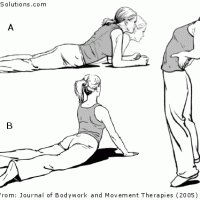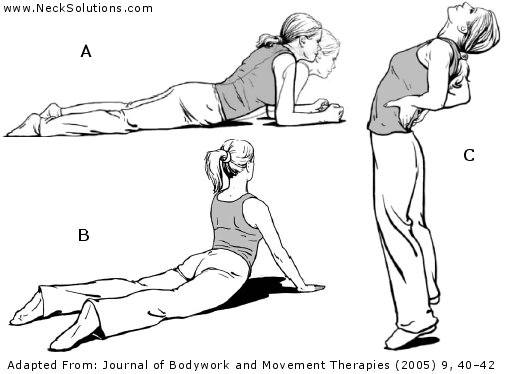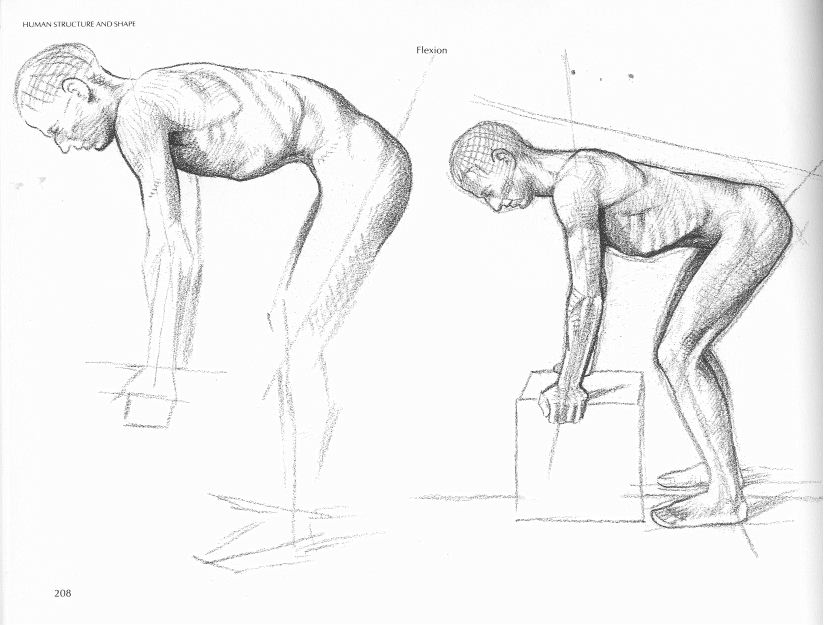
above image shows Mackenzie extension exercises for the flexion intolerant low back
The Flexion-Intolerant Low Back
Low back pain can be caused by a variety of different factors. This can make it hard to pinpoint the root of the problem, as there are different approaches for assessment and treatment of low back pain. Disc herniation, degeneration, and inflammation may or may not cause pain – making it hard to accurately diagnosis the problem. A simple approach for investigating low back pain is to look at movement of the lumbar spine.
A useful framework for identifying and treating the source of low back pain is characterizing low back pain as flexion or extension related.
Extension-based back pain is aggravated by standing for prolonged periods and characterized by an overextended lumbar spine. Flexion-based back pain is aggravated by prolonged sitting and characterized by excessive flexion in the lumbar spine.
This article will examine the flexion-intolerant low back. Typically athletes are prone to being more overextended while office workers are prone to be flexion-intolerant and rounded through the lumbar spine. In both patterns it is important to mobilize the hips and thoracic spine so that the back is stable during movement.
What is Flexion-Intolerance?
Flexion Intolerant low back pain is characterized by symptomatic pain with movement, and possible referral pain into the buttock and/or down one side of the leg (sciatica). Pain is worsened with sustained or repeated flexion.
Clues for Flexion Intolerance
Pain upon waking in the early morning
History of sudden onset of pain during lifting or bending
History of sciatica, buttock, or leg pain
Discomfort/pain getting out of a car/chair from sitting
Discomfort during tasks that require bending (tying shoes)
More pain in sitting than standing
Prolonged sitting during the day
Posture consisting of a flat back/posterior pelvic tilt
Relief with extension based exercises/pain with end-range flexion
Treatment
#1: Remove Flexion
“The first step in any exercise progression is to remove the cause of the pain, namely the perturbed motion and motor patterns. For example, flexion-intolerant backs are very common. Stretches such as pulling the knees to the chest may give the perception of relief (via stimulation of the erector spinae muscle stretch receptors), but this approach only guarantees more pain and stiffness as the underlying tissues sustain more cumulative damage.” – Stuart McGill
A standing workstation and frequent breaks from sitting at work can help (ideally every 20 minutes). Gym exercises that involve lumbar flexion should be avoided (sit-ups/crunches). It is also important to avoid stretching into end-range flexion (yoga and pilates).
It is important for a person with a flexion-intolerant back to stop stretching the hamstrings. Most hamstring stretches involve lumbar flexion (toe touch, seated hamstring stretch) and will intensity symptoms despite proving temporary relief. The tightness in the back of the leg is also likely to be nerve related and not muscle tightness.
Unwanted lumbar flexion often occurs when transitioning to standing from a seated position – these individuals will often round their lumbar spine at the bottom of the squat (butt-wink). It is essential to learn how to move through the hips, keeping an extended lumbar spine during activities of daily living and during gym exercises like squats and deadlifts.
Illustration on left shows excessive lumbar flexion during a lifting task
Right illustration demonstrates good hip hinging mechanics
Image taken from John Hull Grundy’s, “Human Structure and Shape”
#2: Train Hip Movement
It is essential to learn how to flex the hips while keeping a stable back. Flexion-intolerant individuals will substitute lumbar flexion for hip flexion during a movement like the good morning (hip hinge). The hip hinge movement pattern is essential for learning how to disassociate hip movement from low back movement. Box squats, good mornings, and the exercises found in Foundation Training are all good options for restoring hip movement.
Releasing the deep hip flexor (psoas) and adductors can help restore hip motion. Hip internal rotation is especially important for a stable low back during movement.
#3: Exercises
Exercises for flexion-intolerance should aim to migrate the disc away from the spinal cord – this is accomplished by using extension-based exercises (see main image). The MacKenzie press up exercise (B) or the thoracic sphinx pose (A) can be performed lying on the ground (5 reps of 30 second holds – 5x/day). A set of 10 standing extensions (C) can be performed at work (every 20-30 minutes).
In addition to stretching into extension it is important to build low back endurance using exercises like the bird-dog, front plank, ab wheel rollout, and stir the pot.
After competency is achieved through hip hinging, low back extensions, and core exercises – it is important to progress into strength training exercises. The box squat and sumo deadlift are good beginning choices.
A great resource for flexion-intolerance is Fix Your Own Back (link).
– Kevin Kula, “The Flexibility Coach” – Creator of FlexibilityRx™ – www.FlexibilityRx.com
Related Resources
Dynamic Chiropractic: Flexion Intolerant Low Back (link)
FlexibilityRx: Improving Hip Flexion (link)
Fix Your Own Back (link)
Tags: Craig Liebenson, flexion-intolerant back, functional movement, low-back pain, stuart mcvill


Leave A Reply (No comments so far)
You must be logged in to post a comment.
No comments yet